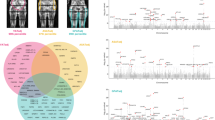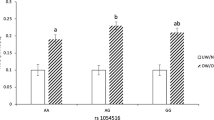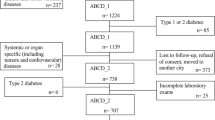Abstract
Objectives: The role of adipsin and adipsin Hinc II polymorphisms on the metabolic and body composition changes in response to overfeeding was studied.
Subjects: A total of 12 pairs of male monozygotic twins ate a 4.2 MJ/day energy surplus, 6 days a week, during a period of 100 days.
Results: The preoverfeeding plasma adipsin concentration correlated positively with the change in CT-measured abdominal total and subcutaneous (P<0.05) fat. The changes in abdominal total fat and abdominal subcutaneous fat correlated negatively with changes in plasma adipsin concentrations (P<0.005). Overfeeding induced greater increases in body weight, fat mass, abdominal total and subcutaneous fat (P<0.05) in 6.1 kb noncarriers (n=10) than in 6.1 kb carriers (n=14) of the adipsin Hinc II polymorphism. The 6.1 kb noncarriers had a greater increase in plasma leptin levels (P<0.01). Also the total (P<0.01) and very-low-density lipoprotein (VLDL)-triglycerides (P<0.05), apolipoprotein B (P<0.05) and VLDL-cholesterol (P<0.05) levels increased more in the 6.1 kb noncarriers than in the 6.1 kb carriers.
Conclusions: Adipsin plasma level could be a predictor of the changes in abdominal subcutaneous fat during times of increased energy intake. However, a greater increase in the abdominal subcutaneous fat was related to a lower increase in the plasma adipsin level. The adipsin Hinc II 6.1 kb allele noncarriers gained more abdominal subcutaneous fat and had a greater increase in plasma levels of leptin- and triglyceride-rich lipoproteins when exposed to a long-term positive energy balance. These findings provide new information on the role of adipsin on individual differences in response to chronically elevated food intake.
This is a preview of subscription content, access via your institution
Access options
Subscribe to this journal
Receive 12 print issues and online access
$259.00 per year
only $21.58 per issue
Buy this article
- Purchase on Springer Link
- Instant access to full article PDF
Prices may be subject to local taxes which are calculated during checkout
Similar content being viewed by others
References
Ahima RS & Flier JS (2000): Adipose tissue as an endocrine organ. Trends Endocrinol. Metab. 11, 327–332.
Bouchard C, Tremblay A, Després J-P, Nadeau A, Lupien PJ, Moorjani S, Thériault G & Kim SY (1996): Overfeeding in identical twins: 5-year postoverfeeding results. Metabolism 45, 1042–1050.
Bouchard C, Tremblay A, Després J-P, Nadeau A, Lupien PJ, Thériault G, Dussault J, Moorjani S, Pinault S & Fournier G (1990): The response to long-term overfeeding in identical twins. N. Engl. J. Med. 322, 1477–1482.
Choy LN, Rosen BS & Spiegelman BM (1992): Adipsin and an endogenous pathway of complement from adipose cells. J. Biol. Chem. 267, 12736–12741.
Cianflone K, Maslowska M & Sniderman AD (1999): Acylation stimulating protein (ASP), an adipocyte autocrine: new directions. Semin. Cell Dev. Biol. 10, 31–41.
Dugail I, Quignard-Boulange A, Le Liepvre X & Lavau M (1990): Impairment of adipsin expression is secondary to the onset of obesity in db/db mice. J. Biol. Chem. 265, 1831–1833.
Gregoire FM, Zhang Q, Smith SJ, Tong C, Ross D, Lopez H & West DB (2002): Diet-induced obesity and hepatic gene expression alterations in C57BL/6J and ICAM-1-deficient mice. Am. J. Physiol. Endocrinol. Metab. 282, E703–E713.
Laurell CB (1966): Quantitative estimation of proteins by electrophoresis in agarose gel containing antibodies. Anal. Biochem. 15, 45–52.
Lohman T, Roche AF & Martorell R (eds) (1988): Anthropometric Standardisation Reference Manual. Human Kinetics: Champaign, IL.
Maslowska M, Vu H, Phelis S, Sniderman AD, Rhode BM, Blank D & Cianflone K (1999): Plasma acylation stimulating protein, adipsin and lipids in non-obese and obese populations. Eur. J. Clin. Invest. 29, 679–686.
Montague CT, Prins JB, Sanders L, Digby JE & O'Rahilly S (1997): Depot- and sex-specific differences in human leptin mRNA expression: implications for the control of regional fat distribution. Diabetes 46, 342–347.
Montague CT, Prins JB, Sanders L, Zhang J, Sewter CP, Digby J, Byrne CD & O'Rahilly S (1998): Depot-related gene expression in human subcutaneous and omental adipocytes. Diabetes 47, 1384–1391.
Müller-Eberhard HJ (1988): Molecular organization and function of the complement system. Annu. Rev. Biochem. 57, 321–347.
Murray I, Sniderman AD & Cianflone K (1999): Mice lacking acylation stimulating protein (ASP) have delayed postprandial triglyceride clearance. J. Lipid. Res. 40, 1671–1676.
Napolitano A, Lowell BB, Damm D, Leibel RL, Ravussin E, Jimerson DC, Lesem MD, Van Dyke DC, Daly PA, Chatis P, White RT, Spiegelman BM & Flier JS (1994): Concentrations of adipsin in blood and rates of adipsin secretion by adipose tissue in humans with normal, elevated and diminished adipose tissue mass. Int. J. Obes. Relat. Metab. Disord. 18, 213–218.
Neitzel H (1986): A routine method for the establishment of permanent growing lymphoblastoid cell lines. Hum. Genet. 73, 320–326.
Pomeroy C, Mitchell J, Eckert E, Raymond N, Crosby R & Dalmasso AP (1997): Effect of body weight and caloric restriction on serum complement proteins, including Factor D/adipsin: studies in anorexia nervosa and obesity. Clin. Exp. Immunol. 108, 507–515.
Rosen BS, Cook KS, Yaglom J, Groves DL, Volanakis JE, Damm D, White T & Spiegelman BM (1989): Adipsin and complement factor D activity: an immune-related defect in obesity. Science 244, 1483–1487.
Spurlock ME, Hahn KJ & Miner JL (1996): Regulation of adipsin and body composition in the monosodium glutamate (MSG)-treated mouse. Physiol. Behav. 60, 1217–1221.
Ukkola O, Rankinen T, Weisnagel SJ, Sun G, Pérusse L, Chagnon YC, Després J-P & Bouchard C (2000): Interactions among the α2-, β2- and β3-adrenergic receptor genes and obesity-related phenotypes in the Québec Family Study. Metabolism 49, 1063–1070.
White RT, Damm D, Hancock N, Rosen BS, Lowell BB, Usher P, Flier JS & Spiegelman BM (1992): Human adipsin is identical to complement factor D and is expressed at high levels in adipose tissue. J. Biol. Chem. 267, 9210–9213.
Wisse BE, Campfield LA, Marliss SB, Morais JA, Tenenbaum R & Gougeon R (1999): Effect of prolonged moderate and severe energy restriction and refeeding on plasma leptin concentrations in obese women. Am. J. Clin. Nutr. 70(3), 321–330.
Yasruel Z, Cianflone K, Sniderman AD, Rosenbloom M, Walsh M & Rodriguez MA (1991): Effect of acylation stimulating protein on the triacylglycerol synthetic pathway of human adipose tissue. Lipids 26, 495–499.
Acknowledgements
We are indebted to Jacques Bouillon, Suzie Hamel, Brigitte Zément, Maryse Lebrun, Martine Marcotte, Josée Lapointe, Henri Bessette, Gilles Bouchard, and Serge Carbonneau for their contributions to this study. Gratitude is expressed to Dr A Nadeau and the staff of the Diabetes Research Unit for the glucose and insulin assays and to Dr Antonella Napolitano-Rosen, Beth Israel Hospital, and Harvard Medical School, Boston, MA 02215, USA for the adipsin assays.
Special thanks to Guy Fournier and Dr Germain Thériault for their role in the management of the study. Thanks also to Claude Leblanc for his statistical support. Supported in part by a grant (DK 34624) from the National Institutes of Health. C Bouchard is partially supported by the George A. Bray Chair in Nutrition.
Author information
Authors and Affiliations
Corresponding author
Rights and permissions
About this article
Cite this article
Ukkola, O., Chagnon, M., Tremblay, A. et al. Genetic variation at the adipsin locus and response to long-term overfeeding. Eur J Clin Nutr 57, 1073–1078 (2003). https://doi.org/10.1038/sj.ejcn.1601644
Received:
Revised:
Accepted:
Published:
Issue Date:
DOI: https://doi.org/10.1038/sj.ejcn.1601644
Keywords
This article is cited by
-
Genes, Fat Intake, and Cardiovascular Disease Risk Factors in the Quebec Family Study
Obesity (2007)
-
The Human Obesity Gene Map: The 2005 Update
Obesity (2006)
-
The Human Obesity Gene Map: The 2004 Update
Obesity Research (2005)



